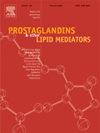Decreased plasma lipoxin A4, resolvin D1, protectin D1 are correlated with the complexity and prognosis of coronary heart disease: A retrospective cohort study
IF 2.5
3区 生物学
Q3 BIOCHEMISTRY & MOLECULAR BIOLOGY
Prostaglandins & other lipid mediators
Pub Date : 2025-03-29
DOI:10.1016/j.prostaglandins.2025.106990
引用次数: 0
Abstract
This study aimed to assess the predictive capacity of specialized pro-resolving mediators (SPMs) regarding the complexity and prognosis of coronary heart disease (CHD). Total of 602 CHD patients were included in this study and categorized into low-risk, medium-risk, and high-risk groups based on the Synergy Between Percutaneous Coronary Intervention with Taxus and Cardiac Surgery (SYNTAX) score. Follow-up was conducted for two years, during which patients were dichotomized into poor and good prognosis groups. Additionally, twenty healthy controls were incorporated. Plasma concentrations of lipoxin A4 (LXA4), resolvin D1 (RvD1), protectin D1 (PD1), C-reactive protein (CRP), interleukin-6 (IL-6), and IL-10 were quantified. Plasma LXA4, RvD1, PD1, and the ratios LXA4/IL-6, RvD1/IL-6, PD1/IL-6 exhibited a gradual decrease across control, low-risk, medium-risk, and high-risk groups and exhibited a negative correlation with the SYNTAX score. Spearman’s correlation analysis revealed negative correlations between plasma LXA4, RvD1, PD1, and both CRP and IL-6, and positive correlations with IL-10. Multiple linear regression models demonstrated negative associations between plasma LXA4, RvD1, PD1, and SYNTAX score. Moreover, both univariate and multivariate binary logistic regression analyses identified plasma LXA4, RvD1, and PD1 as protective factors against medium/high-risk SYNTAX score categorization. In the poor prognosis group, plasma PD1 was reduced at short-term follow-up, and the ratios LXA4/IL-6, RvD1/IL-6, PD1/IL-6 were reduced at long-term follow-up. Plasma LXA4, RvD1, and PD1 demonstrated negative correlations with CHD complexity and potentially served as protective factors against CHD. Plasma PD1 provided predictive value for short-term prognosis, while the ratios LXA4/IL-6, RvD1/IL-6, PD1/IL-6 were indicative for long-term prognosis.
血浆脂素A4、溶解蛋白D1、保护蛋白D1的降低与冠心病的复杂性和预后相关:一项回顾性队列研究
本研究旨在评估特异性促溶介质(SPMs)对冠心病(CHD)复杂性和预后的预测能力。本研究共纳入602例冠心病患者,根据经皮冠状动脉介入治疗与心脏手术(SYNTAX)的协同作用评分分为低危、中危和高危组。随访2年,将患者分为预后不良组和预后良好组。此外,还纳入了20名健康对照。测定血浆中脂素A4 (LXA4)、溶解素D1 (RvD1)、保护素D1 (PD1)、c反应蛋白(CRP)、白细胞介素6 (IL-6)、IL-10的浓度。血浆LXA4、RvD1、PD1及LXA4/IL-6、RvD1/IL-6、PD1/IL-6比值在对照组、低危组、中危组和高危组均呈逐渐下降趋势,与SYNTAX评分呈负相关。Spearman相关分析显示血浆LXA4、RvD1、PD1与CRP、IL-6均呈负相关,与IL-10呈正相关。多元线性回归模型显示血浆LXA4、RvD1、PD1与SYNTAX评分呈负相关。此外,单因素和多因素二元logistic回归分析均发现血浆LXA4、RvD1和PD1是中/高风险SYNTAX评分分类的保护因素。预后不良组短期随访时血浆PD1降低,长期随访时LXA4/IL-6、RvD1/IL-6、PD1/IL-6比值降低。血浆LXA4、RvD1和PD1与冠心病复杂性呈负相关,可能是预防冠心病的保护因素。血浆PD1对短期预后具有预测价值,而LXA4/IL-6、RvD1/IL-6、PD1/IL-6比值对长期预后具有预测价值。
本文章由计算机程序翻译,如有差异,请以英文原文为准。
求助全文
约1分钟内获得全文
求助全文
来源期刊

Prostaglandins & other lipid mediators
生物-生化与分子生物学
CiteScore
5.80
自引率
3.40%
发文量
49
审稿时长
2 months
期刊介绍:
Prostaglandins & Other Lipid Mediators is the original and foremost journal dealing with prostaglandins and related lipid mediator substances. It includes basic and clinical studies related to the pharmacology, physiology, pathology and biochemistry of lipid mediators.
Prostaglandins & Other Lipid Mediators invites reports of original research, mini-reviews, reviews, and methods articles in the basic and clinical aspects of all areas of lipid mediator research: cell biology, developmental biology, genetics, molecular biology, chemistry, biochemistry, physiology, pharmacology, endocrinology, biology, the medical sciences, and epidemiology.
Prostaglandins & Other Lipid Mediators also accepts proposals for special issue topics. The Editors will make every effort to advise authors of the decision on the submitted manuscript within 3-4 weeks of receipt.
 求助内容:
求助内容: 应助结果提醒方式:
应助结果提醒方式:


